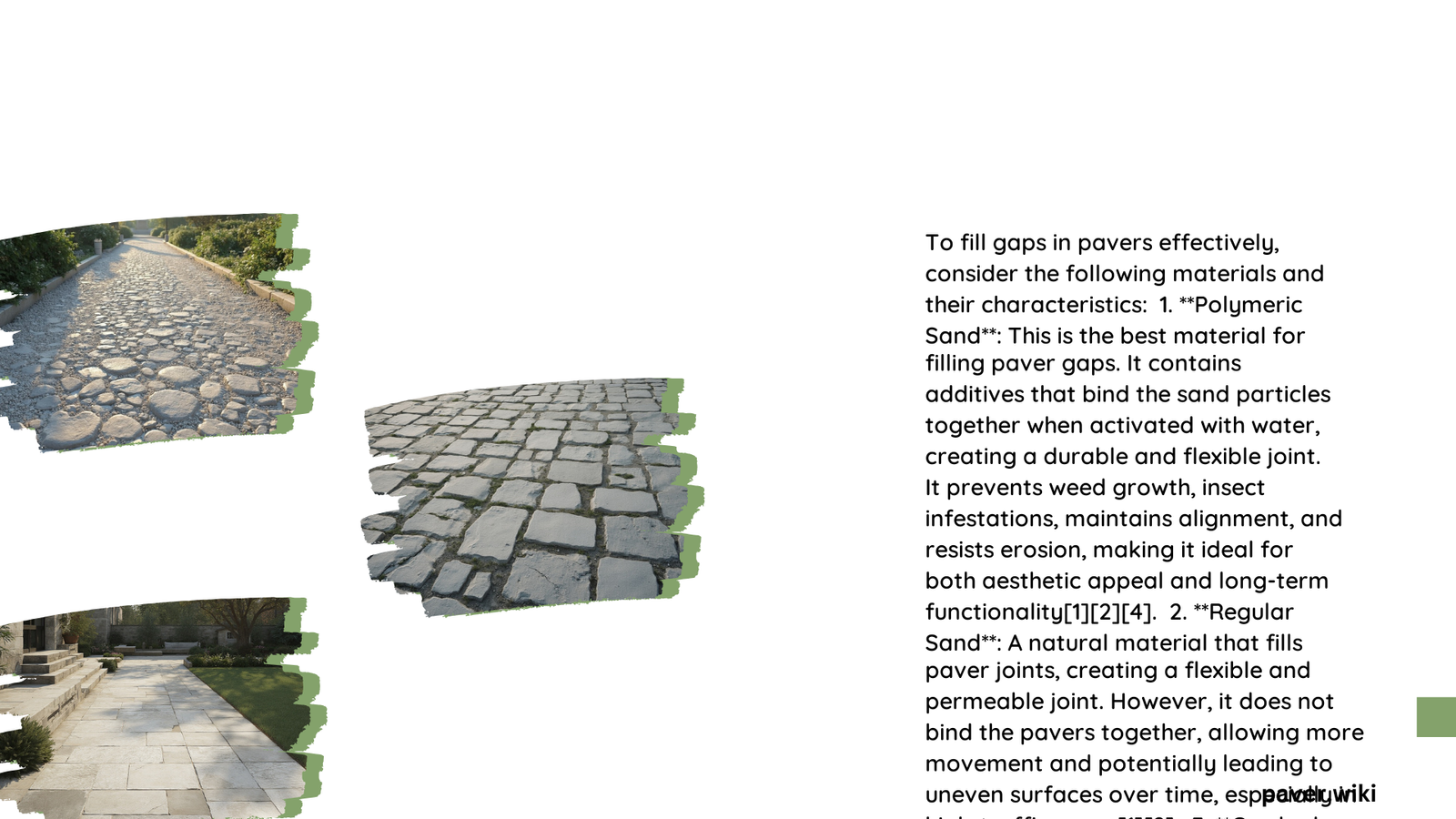Filling gaps in pavers is crucial for stability, weed prevention, and aesthetics. The most common materials used are polymeric sand, regular sand, and small gravel. Polymeric sand is the preferred choice for its durability and binding properties. The choice depends on gap size, paver type, and desired outcome. This guide explores various options and techniques for filling paver gaps effectively.
What is the Best Material to Fill Gaps in Pavers?
The best material for filling gaps in pavers is typically polymeric sand. This specialized product combines fine sand with polymers and binding agents, creating a durable and long-lasting solution for paver joints. When activated with water, polymeric sand hardens, locking pavers in place and preventing weed growth.
Why Choose Polymeric Sand?
- Durability: Resists washing out during rain or cleaning
- Weed prevention: Creates a barrier against weed growth
- Stability: Locks pavers in place, reducing shifting
- Versatility: Suitable for various paver materials and applications
How Wide Should Gaps Be for Polymeric Sand?

Polymeric sand is ideal for specific gap widths:
- Minimum: 1/8 inch (3 mm)
- Maximum: Generally 1/2 inch (1.3 cm), though some products can handle up to 2 inches (5 cm)
- Optimal: Between 1/8 inch (3 mm) and 4 inches (10 cm)
For proper installation, ensure a joint depth of at least 1 inch (2.5 cm).
What Are the Alternatives to Polymeric Sand?
While polymeric sand is popular, other options exist:
- Regular sand
- Small gravel
- Stone dust
- Mortar
Comparison Table: Paver Gap Filling Materials
| Material | Pros | Cons | Best For |
|---|---|---|---|
| Polymeric Sand | Durable, weed-resistant, stabilizing | More expensive, requires careful installation | Most paver applications |
| Regular Sand | Inexpensive, easy to install | Can wash out, allows weed growth | Temporary or budget-friendly solutions |
| Small Gravel | Good drainage, decorative | Can shift, not suitable for narrow gaps | Wider gaps, rustic looks |
| Stone Dust | Compacts well, affordable | Can wash out, less durable than polymeric sand | Budget-friendly projects |
| Mortar | Very durable, permanent | Difficult to remove, less flexible | Permanent installations |
How to Install Polymeric Sand in Paver Gaps?
Follow these steps for proper polymeric sand installation:
- Ensure pavers and joints are completely dry
- Sweep sand into gaps, filling to about 1/8 inch below paver surface
- Use a plate compactor to settle sand (protect textured surfaces)
- Remove excess sand from paver surface
- Activate with water: shower for 30 seconds per 30 sq. ft.
- Allow to cure (typically rain-safe in 15 minutes)
What Precautions Should Be Taken When Filling Paver Gaps?
- Weather conditions: Install on a dry day with no rain forecast for 24 hours
- Surface preparation: Ensure pavers are clean and dry
- Proper depth: Fill gaps to the correct depth (about 1/8 inch below surface)
- Even distribution: Use consistent pressure when sweeping sand
- Avoid over-watering: Follow manufacturer’s instructions for activation
How Much Material is Needed to Fill Paver Gaps?
The amount of material needed depends on:
- Gap width and depth
- Total area of pavers
- Type of material used
For polymeric sand:
– A 50 lb bag typically covers 75-100 sq ft for small gaps
– For wider gaps (1/4\” to 3/8\”), coverage reduces to 30-60 sq ft
Use a polymeric sand calculator for precise estimates based on your project specifications.
What Are the Benefits of Properly Filled Paver Gaps?
- Enhanced stability: Reduces paver movement and shifting
- Improved aesthetics: Creates a clean, finished look
- Weed prevention: Minimizes growth between pavers
- Insect deterrent: Reduces hiding spots for pests
- Easier maintenance: Simplifies cleaning and upkeep
- Increased longevity: Protects paver edges from chipping and wear
How Often Should Paver Gaps Be Refilled?
The frequency of refilling depends on several factors:
- Material used (polymeric sand lasts longer than regular sand)
- Weather conditions and exposure
- Traffic and usage
As a general guideline:
– Polymeric sand: Every 3-5 years
– Regular sand: Annually or as needed
– Gravel: Top up as settling occurs
Inspect your pavers regularly and refill gaps when material loss is noticeable.
Can Paver Gaps Be Filled with Concrete?
While concrete can be used to fill paver gaps, it’s not typically recommended for several reasons:
- Lack of flexibility: Concrete is rigid and may crack with ground movement
- Difficulty in repairs: Hard to remove if pavers need adjustment
- Aesthetic concerns: May not match paver appearance
- Drainage issues: Can impede proper water drainage
For most applications, polymeric sand or other specialized paver joint fillers are preferable to concrete.
By understanding the options and techniques for filling gaps in pavers, you can choose the best solution for your specific project. Whether opting for the durability of polymeric sand or the simplicity of regular sand, proper installation and maintenance will ensure a beautiful, long-lasting paver surface.
